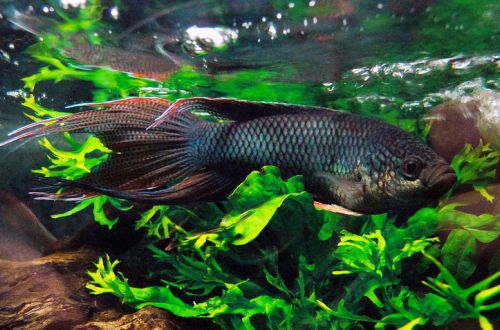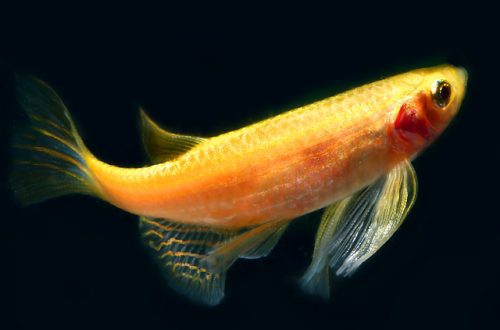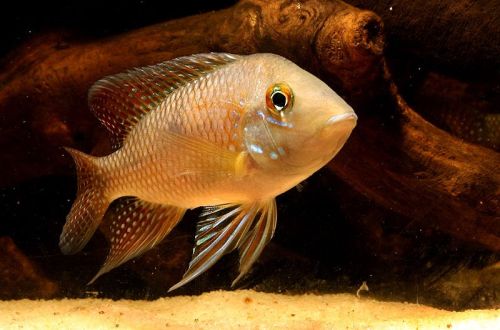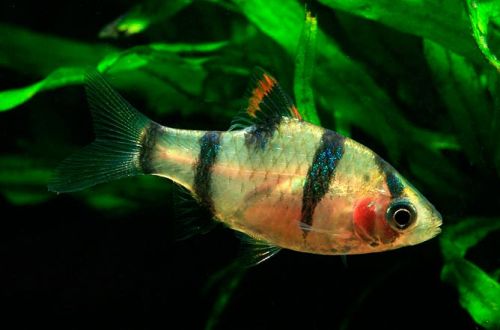
Macropod black
The black macropod, scientific name Macropodus spechti, belongs to the family Osphronemidae. The old name is not uncommon – Concolor Macropod, when it was considered the color form of the classic Macropod, but since 2006 it has become a separate species. A beautiful and hardy fish, easy to breed and maintain, successfully adapts to various conditions and can be recommended to beginner aquarists.

Contents
Habitat
Initially, it was believed that the islands of Indonesia were the homeland of this species, but until now, representatives of Macropodus have not been found in this region. The only place where he lives is the province of Quang Ninh (Quảng Ninh) in Vietnam. The full range of distribution remains unknown due to ongoing confusion about the nomenclature and number of species included in any given genus.
It lives on the plains in numerous tropical swamps, streams and backwaters of small rivers, characterized by slow flow and dense aquatic vegetation.
Brief information:
- The volume of the aquarium – from 100 liters.
- Temperature – 18-28°C
- Value pH — 6.0–8.0
- Water hardness – soft to hard (5-20 dGH)
- Substrate type – any
- Lighting – subdued
- Brackish water – no
- Water movement – little or no
- The size of the fish is up to 12 cm.
- Meals – any
- Temperament – conditionally peaceful, timid
- Keeping alone or in pairs male / female
Description
Adult individuals reach a length of up to 12 cm. The color of the body is dark brown, almost black. Unlike females, males have more elongated extended fins and a tail with a dark crimson tint.
Food
Will accept quality dry food in combination with live or frozen foods such as bloodworms, daphnia, mosquito larvae, brine shrimp. It is worth remembering that a monotonous diet, for example, consisting exclusively of one type of dry food, negatively affects the general well-being of the fish and leads to a noticeable fading of the color.
Maintenance and care, arrangement of the aquarium
The size of the tank for keeping two or three fish starts from 100 liters. The design is arbitrary, subject to several basic requirements – a low level of illumination, the presence of shelters in the form of snags or other decorative objects, and dense thickets of shade-loving plants.
This species is highly adaptable to different water conditions over a wide range of pH and dGH values and at temperatures close to 18°C, so an aquarium heater can be dispensed with. The minimum set of equipment consists of a lighting and filtration system, the latter is configured in such a way as not to create an internal current – the fish do not tolerate it well.
The black macropod is a good jumper that can easily jump out of an open tank, or injure itself on the internal parts of the lid. In this connection, pay special attention to the lid of the aquarium, it should fit snugly to the edges, and internal lights and wires are securely insulated, while the water level should be lowered to 10–15 cm from the edge.
Behavior and Compatibility
The fish are tolerant of other species of similar size and are often used in mixed aquariums. As neighbors, for example, flocks of Danio or Rasbora are suitable. Males are prone to aggression towards each other, especially during the spawning period, so it is recommended to keep only one male and several females.
Breeding / breeding
During the mating season, the male builds a kind of nest of bubbles and pieces of plants near the surface of the water, where the eggs are later placed. Spawning is recommended to be carried out in a separate tank with a volume of 60 liters or more. There are enough clusters of Hornwort in the design, and from the heater equipment, a simple airlift filter and a dense cover with a low-power lamp. The water level should not exceed 20 cm. – imitation of shallow water. It is filled with water from the general aquarium just before the fish are released.
The incentive for spawning is an increase in temperature to 22 – 24 ° C in the general aquarium (you can’t do without a heater here either) and the inclusion of a large amount of live or frozen food in the diet. Soon the female will noticeably round up, and the male will start building the nest. From this moment on, he is transplanted into a hotel tank and the nest is rebuilt already in it. During construction, the male becomes aggressive, including towards potential partners, therefore, for this period, the females remain in the general aquarium. Subsequently, they merge. Spawning itself takes place under the nest and is similar to a “hug”, when the couple is closely pressed against each other. At the point of climax, milk and eggs are released – fertilization occurs. The eggs are buoyant and end up right in the nest, those that accidentally sailed away are carefully placed in it by their parents. All can be laid up to 800 eggs, however the most common batch is 200-300.
At the end of spawning, the male remains to guard the masonry and fiercely defends it. The female becomes indifferent to what is happening and retires to the common aquarium.
The incubation period lasts for 48 hours, the fry that have appeared remain in place for a couple of days. The male protects the offspring until they become free to swim, on this the parental instincts weaken and he is returned back.
Fish diseases
The main cause of most diseases is unsuitable living conditions and poor-quality food. If the first symptoms are detected, you should check the water parameters and the presence of high concentrations of hazardous substances (ammonia, nitrites, nitrates, etc.), if necessary, bring the indicators back to normal and only then proceed with treatment. Read more about symptoms and treatments in the Aquarium Fish Diseases section.





